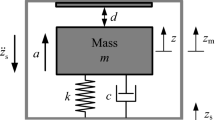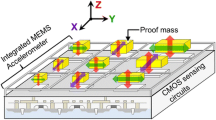Abstract
High performance inertial MEMS require appropriate damping estimation and control. In any MEMS device, the ratio of the surface area to volume is large for which we need to do dynamic performance analysis. Inertial MEMS sensors find its suitability in varied applications and bio-motion sensors are no exception. One of such low frequency applications is the early detection of neurological disorders, targeted specially for pregnant women suffering from tremors, epilepsy and seizures. It becomes very important to capture the most feeble tremor (0 g) to a sudden jerk (±6 g) where the person usually falls. During Pregnancy, most of the drugs for curing neuro-disorders are not suitable to be consumed. Therefore, high performance micro-sensors are required for early detection of tremors (2−12 Hz) and seizure (0.5−29 Hz). An attempt has been made to design a micro sensor with adequate damping estimation by comparing it with the existing models. The proposed MEMS sensor simulated for the target application has an air gap of 23.5 μ which produces around 0.7 damping ratio. Finally, time dependent analysis is done by comparing both with intended damping and very low damping value. We obtain smooth characteristics for the intended damping and overriding oscillations appear for very low damping. Hence, the proposed inertial MEMS sensor has a dynamic range of ±6 g, frequency range of 0−25 Hz and damping ratio of 0.7. Therefore, the proposed microsensor makes it suitable for early detection of neurological disorders especially during pregnancy addressing maternal health care.
Access this chapter
Tax calculation will be finalised at checkout
Purchases are for personal use only
Similar content being viewed by others
References
Bao M, Yang H (2007) Squeeze film air damping in mems. Sens Actuators, A 136:3–27
Marsden C, McAuley J (2000) Physiological and pathological tremors and rhythmic central motor control. J Neurology, Brain 123 (8), 1545–1567
Biswas S, Gogoi AK (2018) Design of a Piezoresistive Microaccelerometer with High Sensitivity for Medical Diagnostic, In proc. Advances in Systems, Control and Automation, Lecture Notes in Electrical Engineering, Singapore: Springer 442:481–490
Blech JJ (1983) On isothermal squeeze films, vol105. p 615
Lu Q, Fang W, Wang C et al (2021) Investigation of a complete squeeze-film damping model for MEMS devices. MicrosystNanoeng 7:54. https://doi.org/10.1038/s41378-021-00279-6
Starr JB (1990) Squeeze-film damping in solid-state accelerometers. In: 4th Technical digest on solid-state sensor and actuator workshop. pp. 44–47
Veijola T (2006) Analytic damping model for an mem perforation cell, vol 2. pp 249–260
Griffin WS, Richardson HH, Yamanami (1966) A study of fluid squeeze-film damping, vol 88.
Sumali H (2007) An experiment to determine the accuracy of squeeze-film damping models in the free molecule regime. In: ASME International mechanical engineering congress and exposition. J Micro Nano systems, Parts A and B 11
Biswas S, Gogoi AK (2018) Squeeze film damping control of a piezoresistive micro accelerometer for neurological disease diagnosis. In: Proceedings of Euromech conference of dynamics of micro and nano electromechanical systems multifield modelling and analysis
Chang L (2006) Piezoresistive sensors, Foundation of MEMS. NG Prentice Hall
Acknowledgements
I would like to thank IIT Guwahati for providing the research facilities and the doctors/Associate Professors from Silchar Medical College, Assam India, namely Dr. Moushumi Biswas and Dr. Debajit Das for helping me with medical related works. I got to know more on pathological tremor and other neurological disorders specially for Pregnant woman. Dr. Biswas is an expert in Community medicine and has immense contribution towards society specially in rural areas. I would like to thank her specially for arranging my visit to Guwahati Medical and Silchar Medical for case studies.
Author information
Authors and Affiliations
Corresponding author
Editor information
Editors and Affiliations
Rights and permissions
Copyright information
© 2023 The Author(s), under exclusive license to Springer Nature Singapore Pte Ltd.
About this chapter
Cite this chapter
Biswas, S., Gogoi, A.K., Biswas, M. (2023). Damping Estimation and Analysis for High Performance Inertial MEMS for Early Detection of Neurological Disorders During Pregnancy. In: Guha, K., Dutta, G., Biswas, A., Srinivasa Rao, K. (eds) MEMS and Microfluidics in Healthcare. Lecture Notes in Electrical Engineering, vol 989. Springer, Singapore. https://doi.org/10.1007/978-981-19-8714-4_11
Download citation
DOI: https://doi.org/10.1007/978-981-19-8714-4_11
Published:
Publisher Name: Springer, Singapore
Print ISBN: 978-981-19-8713-7
Online ISBN: 978-981-19-8714-4
eBook Packages: Biomedical and Life SciencesBiomedical and Life Sciences (R0)




